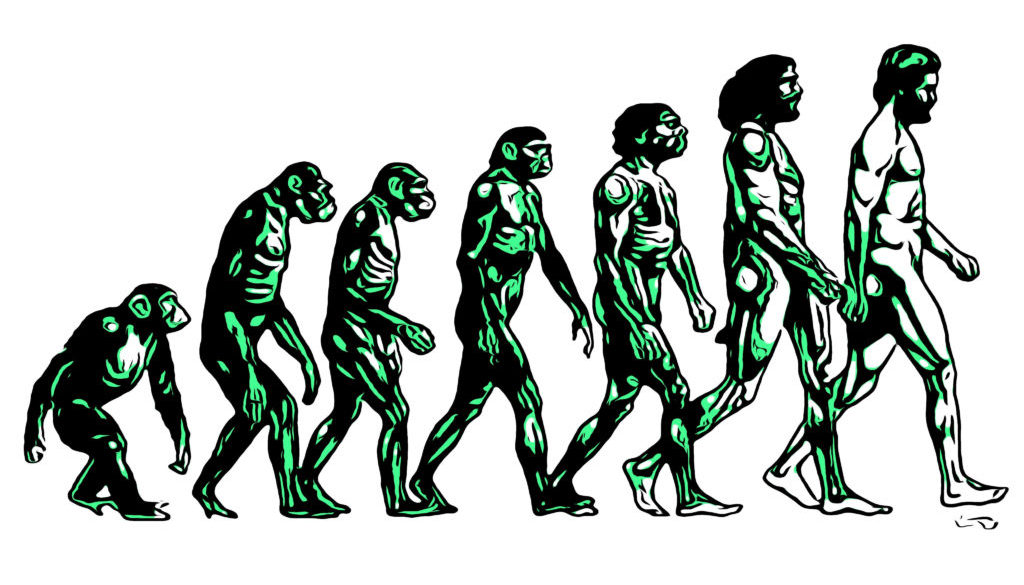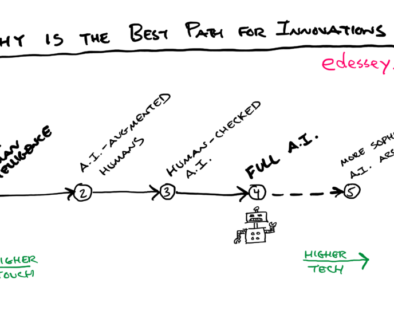A Maturity Model for Incubation Projects
The model: Empathy > Stickiness > Spread > Impact > Scale
Many innovators and innovation leaders are looking for a maturity model for innovation projects. You can find my favorite answer within one of the earliest books of the Lean Series. It provides a powerful model for understanding the maturity of a business along with the metrics and strategy it can employ for the fastest growth.
This is an article of a new series on what happens in the incubation zone.
A Maturity Model of Innovation
Lean Analytics by Croll and Yoskovitz focuses on finding the one metric that matters most in businesses as they mature. They understood that this one metric would change based on the phase of the business.
Toward this, they identified a series of 5 phases that are the happy path of growth for a new business, specifically:
Empathy > Stickiness > Virality > Revenue > Scale
Working in innovation with many large organizations, like enterprises, governments, and non-profits, there are two translations to make and a key insight to share.
First, the translation from Virality —> Spread is important. In The Lean Startup, Eric Ries identified three engines of growth for a business: the sticky engine, the viral engine, and the paid engine. Large organizations can often get incredible gains out of any of these engines, so it’s important to leave them all on the table.
Note: As much as I’m tempted to call this phase Growth, really all of the phases are about the growth of a different metric, so I will reserve that here as a more general term.
Second, the translation from Revenue —> Impact is also important once you leave the startup (standalone business) domain and head into other fields. Revenue is a type of impact that may still apply, but there are other kinds of impact as well. For instance, the development of a new military innovation may have completely different objectives, likewise an internal internal investment in a corporation, and the focus of a nonprofit isn’t primarily on revenue.
This changes the phases of the maturity model to:
Empathy > Stickiness > Spread > Impact > Scale

Third, the key insight is that large organizations tend to be very good at picking up an innovation after it crosses a particular threshold in Spread. They can maximize these for Impact and then Scale.
Note: In Blitzscaling from Reid Hoffman and David Yeh, they argue to pour a lot of resources into Growth once a number of conditions are met in order to out-pace the competition. The time to do that is once a threshold is hit showing a successful spread tactic. Dave Binetti calls this the WOM PROM Score — more on that another time.
Before going any further, let’s take a moment to discuss the phases in order. Let’s start where new business idea start, with the Empathy Phase.
The Empathy Phase
The Empathy phase is about answering the question “Is there an audience that cares about this?”
This begins with problem validation, or if you prefer, validating the job to be done or the opportunity.
This is about finding whether there are people who care about the problem.
The methods employed here are typically behavioral observation or interviews about past behavior.
Note: This has many names, depending on who you read. For instance, in Steve Blank’s Customer Development, this is the Customer Discovery phase.
After problem validation, when you have successfully validated the problem, now is the time for solution validation. This is trying to answer if you have the right approach to solving the problem for the people who have it.
Take the quickest and cheapest ways to answer the questions in this area. As an advocate of design thinking, I like using different forms of prototypes here. The design thinking and lean startup disciplines have a lot of ways to do this.
After this, move on to creating an MVP that people will use. Focus on a high touch experience for a few users. This is how you will learn the most, and allow you to move more quickly later.
Once, there you are ready for the next phase.
The Stickiness Phase
The Stickiness phase is about driving up retention in the existing solution.
Employ great design and growth hacking methods to get a few people to love what you are doing then move on to more through progressive disclosure.
To begin, I recommend operating in stealth mode.
Stealth Mode
If this project may be very visible, as almost everything is that come from a large organization or company, you will likely want to do some of this in secret. Here’s a major difference from startups, there are just different laws of physics here. You need to put things in place to slow the spread of the idea until you are ready to make use of it.
A common mistake is a sugar-crash release, where a large, well-known company can reach large volumes of users on day 1, without being ready for them. Then, the next week, none of them have stuck around. So, you want to work out stickiness first, some of it in secret.
To make the best use of this, there are several things that you want to accomplish in this phase.
1. Work out major problems – It’s important to address major issues that may inadvertently offend people, become PR stories, or just break in terrible ways. You don’t want to do this in public.
2. Earn retention – This avoids the sugar crash.
3. Earn raving fans – You want people who love your project, use it, and are willing to promote it on their own. This word of mouth (WOM) is key to later crossing the chasm (ref: Crossing the Chasm by Geoffrey Moore.). This will really help in the spread phase.
Once you have achieved these three things, you are ready to increase your exposure gradually to see if you maintain the stickiness. This is often measured in retention % or some N days return rate metric.
Some ways to do this are through a referral mechanism, more invitations, or eventually a public release. There’s a ton of specifics I’ve learned here that I can share in a later post.
If you are able to consistently spread to more users and maintain your stickiness, you are ready for the high octane, Spread phase.
The Spread Phase
In the Spread phase, you will increase you exposure and reach to users as fast as possible, maximizing your growth engine.
A big part of this is through creating new channels and developing them as effectively as possible.
The first phase of this is channel development, in which the team develops an effective channel and optimizes for spread (not necessarily for efficiency).
Beyond this, put the pedal to the floor to grow as quickly as possible. If you can get to a high growth rate (which we can discuss in a later post), pour on the gas.
Note: That’s not to say as efficiently as possible. While efficiency will save costs and increase the spread rate, a sticky solution is often better spread quickly instead of efficiently. So, a savvy team optimizes to speed while keeping the channel only as efficient as needed to not run out of money while growing.
In a powerful concept by Dave Binetti, you are looking for product-market fit as measured by a great WOM-PROM Score (WPS). WOM is for Word Of Mouth and PROM is for PROMotional activity. In this WOM = the # of users gained through WOM referrals and PROM = the # of users gains through your promotional activity. You will want to tag each user with whether they came from WOM or PROM.
WPS = WOM / (WOM + PROM ) x 100%
In English, this is the the % of users that came from word of mouth activities.
This is the time to pass to the corporation for spreading as fast as possible. Now is the time to enter Blitzscaling.
And when WPS is between 40% and 60%, you’re ready to blitzscale. If it’s below .4, you are not ready to cross the chasm into the early majority, and if it’s about .6, you haven’t optimized your promotional activity enough.
The Impact Phase
Beyond Spread is a focus on Impact.
The Impact phase is about maximizing the impact that this venture can have on the world and your business. Impact is often measured in revenue, but this is usually in whatever metric is the bottom line under the control of this piece of the organization.
Until now, you have validated that it can have an impact. In the case where impact = revenue, you hopefully already made some revenue before leaving the Empathy phase. You need to do that in order to know if somebody would buy it. However, you maximized that phase for Empathy. Now, you want to maximize for Impact (i.e., in this case, Revenue).
At this point, the project is firmly rooted in what Geoffrey More called the Transformation Zone in his amazing book Zone to Win.

Large organizations do this so well that I will gloss over this here as outside the scope of this discussion. This goes into the final phase of Scaling that large organizations are exceptionally good at.
The Scale Phase
The Scale phase is when an organization takes the idea across the entire company, it’s reach globally, across all developed channels, and even into adjacent sectors that it touches.
A project typically begins the Scale Phase while in the Transformation Zone and then moves into the Performance Zone as it becomes a major contributor (>10%) to the bottom line.
It is well positioned to use all of the resources of the organization to scale and make an enormous impact.
If you liked that one, there’s plenty more coming soon.
Coming Soon
This post came about from requests from other innovators and innovation leaders. It has been on the minds of many. Other topics on deck also come from requests:
A. How to introduce new project teams to the incubation zone.
B. What happens in the incubation zone
C. How to move projects out of the incubation zone
If you have other questions in mind, please share with me or in the comments.
If You Found This Useful
You can engage in the following ways:
- Subscribe to receive follow-ups.
- Share if you know someone else who will benefit.
- Comment with questions and stories so that others can benefit from your thoughts.
We’re all in this together!
Keep growing what matters the most to you!



The World's Top Innovation Models in One Chart - Ed Essey
May 15, 2020 @ 5:09 am
[…] I also teased at a new artifact that many innovators have been excited about. It builds on the Maturity Model for Incubation. […]
May 26, 2020 @ 5:23 pm
Like!! Great article post.Really thank you! Really Cool.
Data Are People First - Ed Essey
June 27, 2020 @ 5:01 pm
[…] / project is best when it is build on empathy. That’s why Empathy as the first phase in the maturity model for incubation projects. It’s why I anchor to the empathy POV in the world’s top innovation models in one chart. Yes, […]